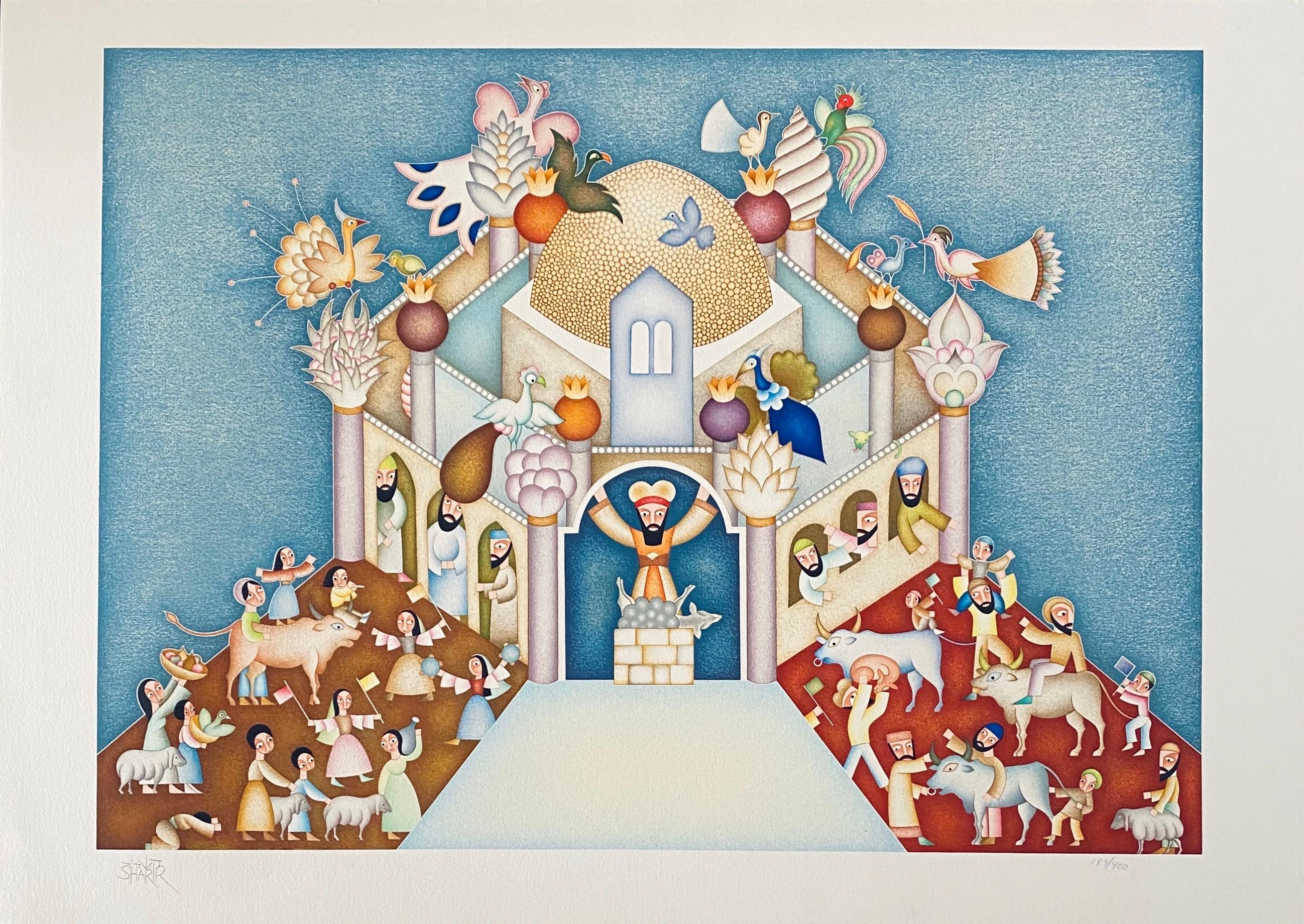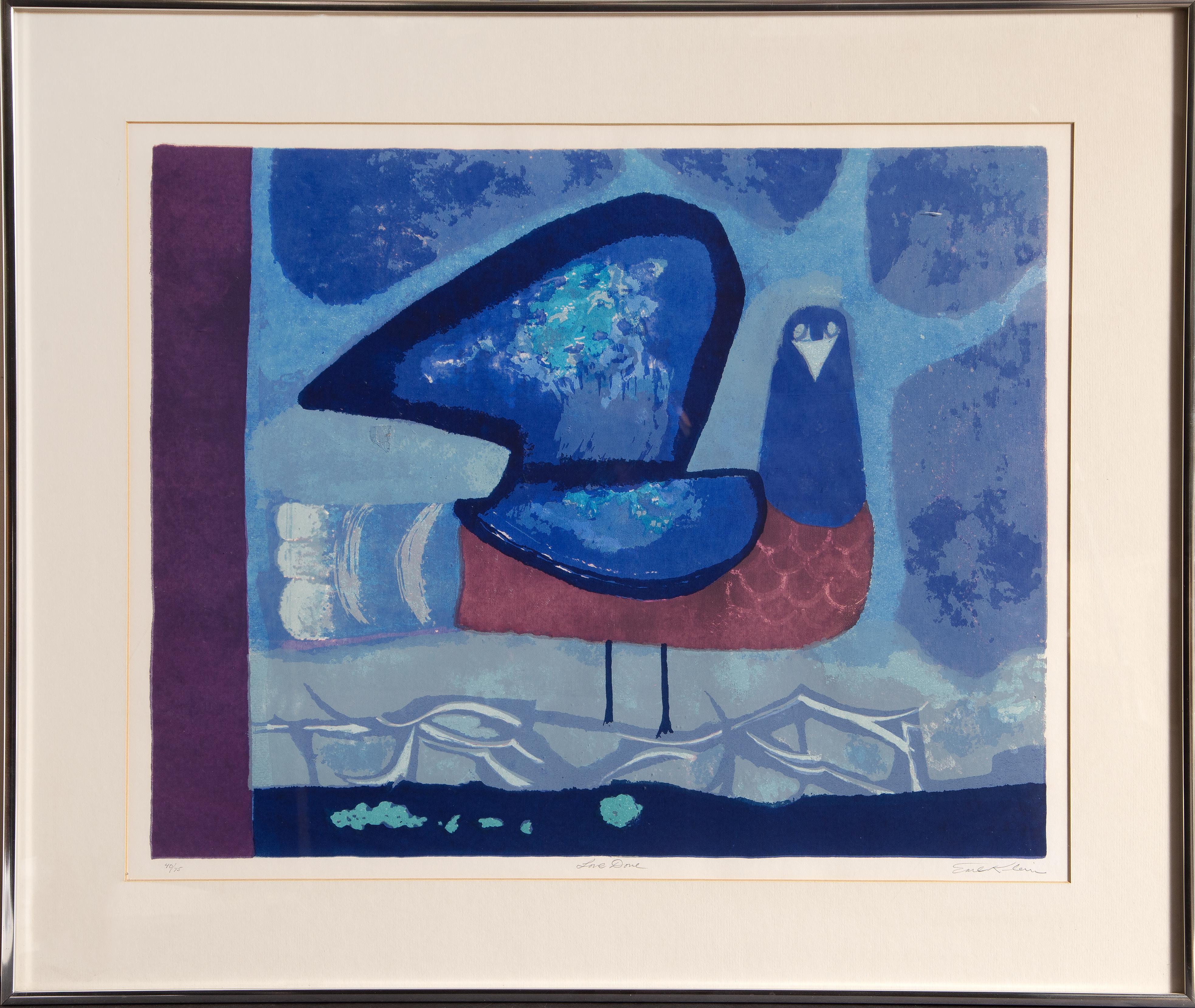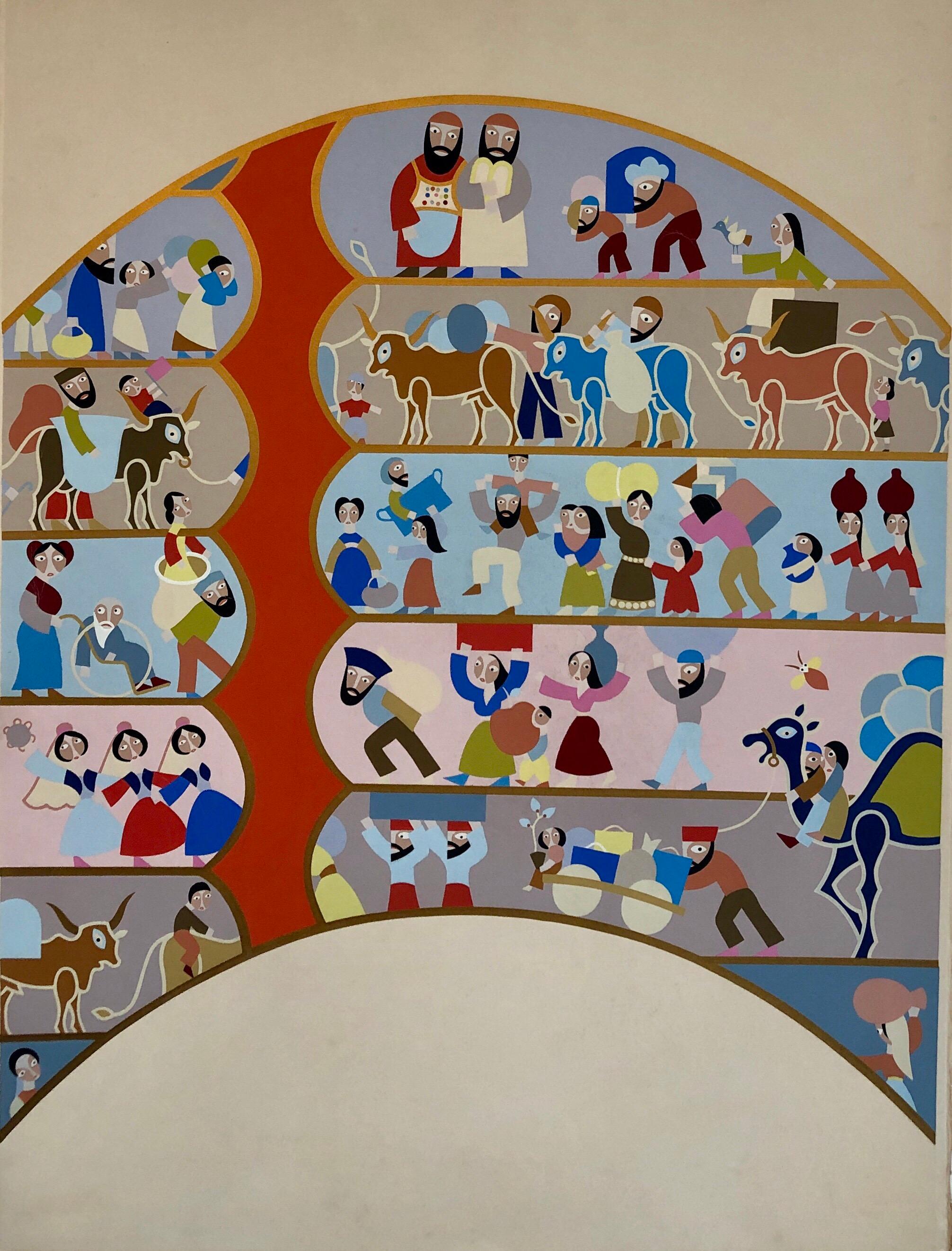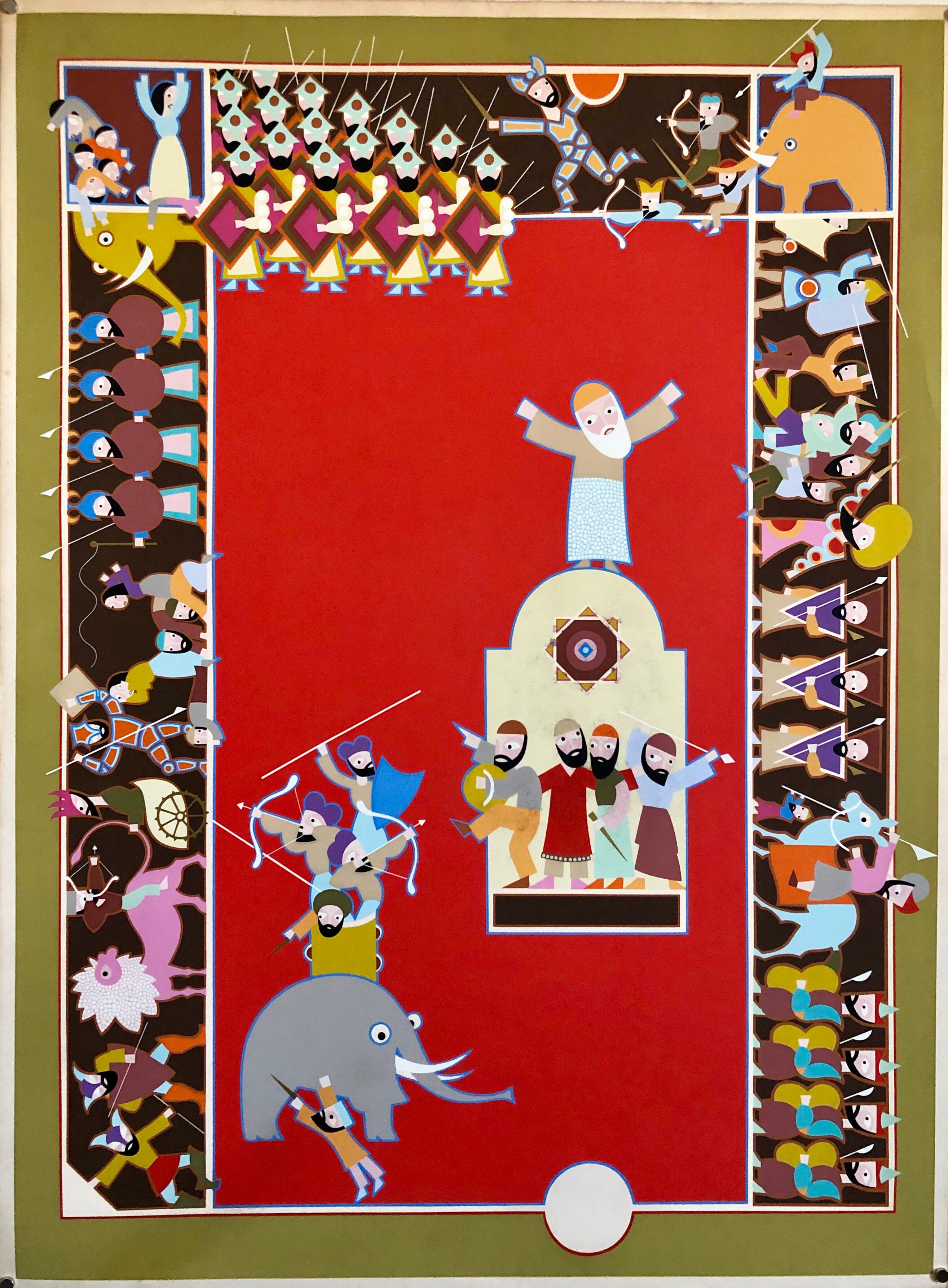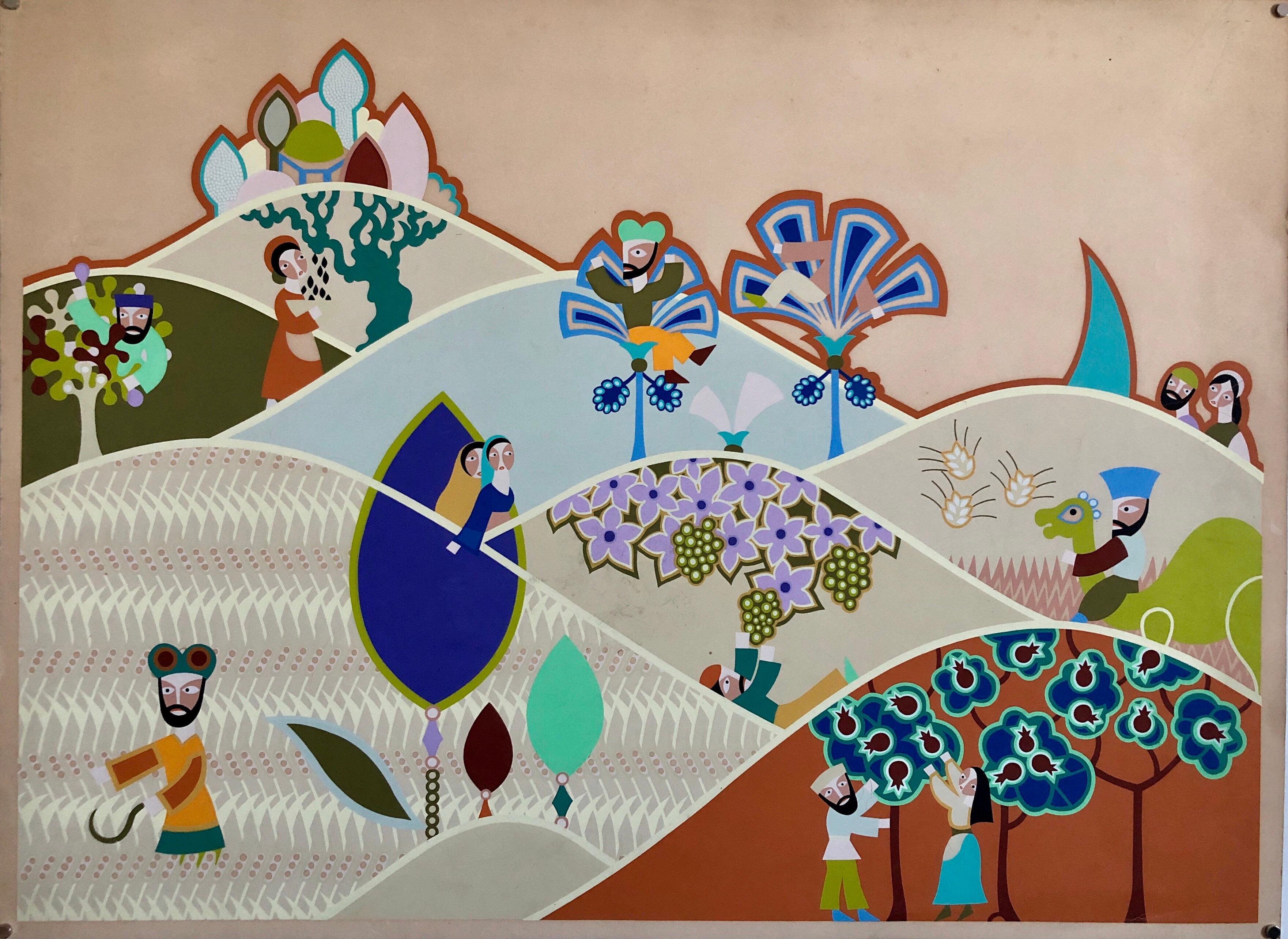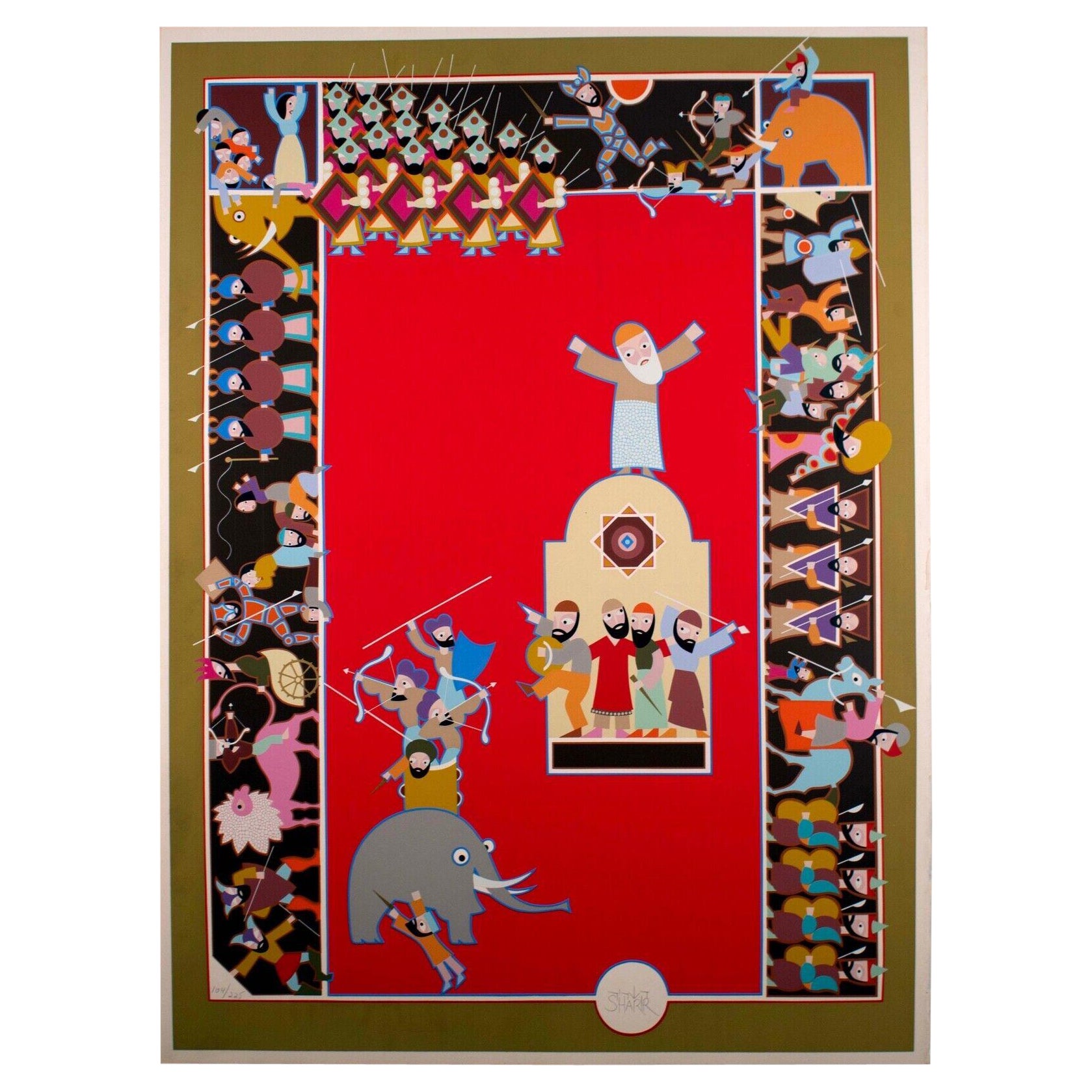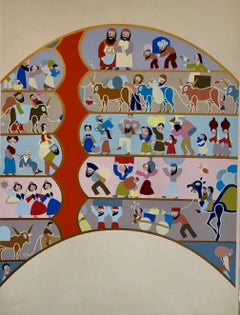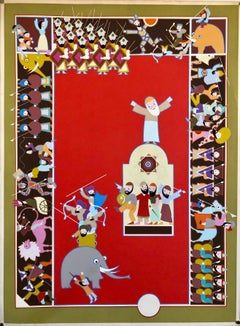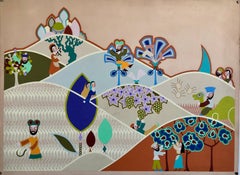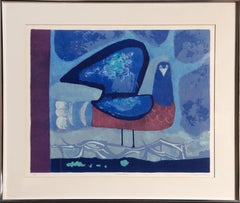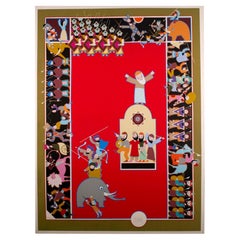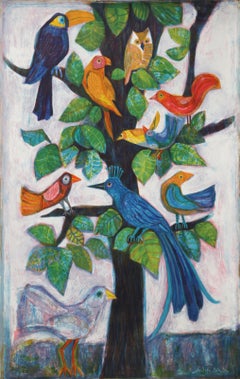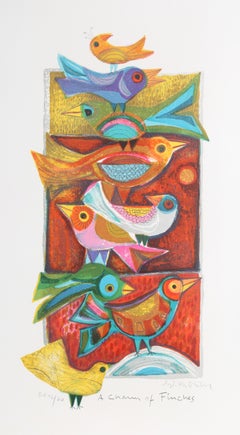Items Similar to Israeli Naive Folk Art Birdhouse Silkscreen Lithograph David Sharir Birds
Want more images or videos?
Request additional images or videos from the seller
1 of 14
David SharirIsraeli Naive Folk Art Birdhouse Silkscreen Lithograph David Sharir Birds
$1,200
£935.03
€1,060.77
CA$1,724.67
A$1,899.03
CHF 984.73
MX$22,489.71
NOK 12,500.50
SEK 11,683.14
DKK 7,922.67
About the Item
David Sharir was born in 1938 in Tel Aviv, Israel and currently resides there.
David Sharir, the son of Russian immigrants, was born in Israel. Beginning his study of art in Tel Aviv and continuing in Florence and Rome, where he studied architecture and theater design. The brightly colored costumes and intricate stage designs he created for these productions have profoundly influenced his art. When Sharir moved to Old Jaffa in 1966, his hallmark style was truly developed. Studio, family, and spiritual devotion all serve as inspiration for the imagery in his work. His evolving style combines personal experience, Biblical symbolism, and fantasy.
Israel has had a Vibrant Folk Art, Naive art scene for a long time now artists like Yisrael Paldi, Nahum Guttman, Reuven Rubin and even Yefim Ladyzhensky had naive periods. The most well know if the strict naive artists are Shalom of Safed, Irene Awret Gabriel Cohen, Natan Heber, Michael Falk Kopel Gurwin. Sharir depicted biblical subjects with a touch of humour and designed sets and costumes for the theatre and opera.
Graphic Art in Israel Today Tel Aviv Museum, Tel Aviv 1973
Israel 1948-1958: Watercolors, Drawings, Graphics
The Bezalel National Museum, Jerusalem 1958
Jean David, Yosl Bergner, Menachem Shemi, Zvi Mairovich, Ruth Schloss, Nahum Gutman, Moshe Elazar Castel, Marcel Janco, Abel Pann, Amos Yaskil, Mordechai Levanon, Reuven Rubin, Maryan, Pinchas Litvinovsky, Ludwig Blum.
Education Avni Institute, Tel Aviv.
Advanced studies with Aharon Kahana, Yohanan Simon and Israel Paldi.
1959-1961 Florence, Fine Arts Academy.
1964-1961 University of Rome, Architecture.
- Creator:David Sharir (1938, Israeli)
- Dimensions:Height: 30.5 in (77.47 cm)Width: 23.8 in (60.46 cm)
- Medium:
- Movement & Style:
- Period:
- Condition:good. minor wear.
- Gallery Location:Surfside, FL
- Reference Number:1stDibs: LU38214901242
David Sharir
David Sharir: A leading contemporary Israeli artist, David Sharir first studied art in Tel Aviv. He then became a student at the Academia del Bella Arte, Florence, Italy, and studied both architecture and theatre design at the University of Rome. Upon his return to Israel, David Sharir first gained fame for his many great theatre designs. His first one man exhibitions of art took place in Tel Aviv (1959) and Rome (1961). Since that time his art has been frequently exhibited in Israel, Italy, Germany, France and the United States. David Sharir's original prints and paintings are now included in such major collections as the Tel Aviv Museum, Israel, the Israel Museum, Jerusalem, the Philadelphia Museum of Art and the Los Angeles County Museum. The art of David Sharir draws upon many elements. He has found inspiration from such forms of art as the calligraphy of Torah scribes, medieval Hebrew manuscripts, the paintings of Italian primitives and the work of Russian folk art to create his own both beautiful and highly decorative style.
About the Seller
4.9
Platinum Seller
Premium sellers with a 4.7+ rating and 24-hour response times
Established in 1995
1stDibs seller since 2014
1,836 sales on 1stDibs
Typical response time: 1 hour
- ShippingRetrieving quote...Shipping from: Surfside, FL
- Return Policy
More From This Seller
View AllIsraeli Naive Folk Art Silkscreen Lithograph David Sharir - Bet Hamikdash Scene
By David Sharir
Located in Surfside, FL
David Sharir was born in 1938 in Tel Aviv, Israel and currently resides there.
David Sharir, the son of Russian immigrants, was born in Israel. Beginning his study of art in Tel Aviv...
Category
20th Century Folk Art Figurative Prints
Materials
Screen
Israeli Modern Passover Lithograph Silkscreen David Sharir Holiday Art Serigraph
By David Sharir
Located in Surfside, FL
This is a mixed lithograph and serigraph silkscreen as per descriptions i read. this is not signed or numbered. it is a rare artists or printers proof print. It depicts Moses and Aaron at the top and I believe it relates to Passover and the exodus from Egypt.
David Sharir was born in 1938 in Tel Aviv, Israel and currently resides there.
David Sharir, the son of Russian immigrants, was born in Israel. Beginning his study of art in Tel Aviv and continuing in Florence and Rome, where he studied architecture and theater design. The brightly colored costumes and intricate stage designs he created for these productions have profoundly influenced his art. When Sharir moved to Jaffa in 1966, his hallmark style was truly developed. Studio, family, and spiritual devotion all serve as inspiration for the imagery in his work. His evolving style combines personal experience, Biblical symbolism, and fantasy.
David Sharir, born 1938, Tel Aviv. Was among the first artists to settle in Old Jaffa in 1966. He depicted biblical subjects with a touch of humour and designed sets and costumes for the theatre and opera.
Graphic Art in Israel Today Tel Aviv Museum, Tel Aviv 1973
Israel 1948-1958: Watercolors, Drawings, Graphics
The Bezalel National Museum, Jerusalem 1958
Jean David, Yosl Bergner, Menachem Shemi, Zvi Mairovich, Ruth Schloss, Nahum Gutman, Moshe Elazar Castel...
Category
20th Century Contemporary Figurative Prints
Materials
Lithograph
Israeli Modern Hanukkah Lithograph Silkscreen David Sharir Holiday Serigraph Art
By David Sharir
Located in Surfside, FL
This is a mixed lithograph and serigraph silkscreen as per descriptions i read. this is not signed or numbered and is marked sample. it is a rare artists or printers proof print.
David Sharir was born in 1938 in Tel Aviv, Israel and currently resides there.
David Sharir, the son of Russian immigrants, was born in Israel. Beginning his study of art in Tel Aviv and continuing in Florence and Rome, where he studied architecture and theater design. The brightly colored costumes and intricate stage designs he created for these productions have profoundly influenced his art. When Sharir moved to Jaffa in 1966, his hallmark style was truly developed. Studio, family, and spiritual devotion all serve as inspiration for the imagery in his work. His evolving style combines personal experience, Biblical symbolism, and fantasy.
David Sharir, born 1938, Tel Aviv. Was among the first artists to settle in Old Jaffa in 1966. He depicted biblical subjects with a touch of humour and designed sets and costumes for the theatre and opera.
Graphic Art in Israel Today Tel Aviv Museum, Tel Aviv 1973
Israel 1948-1958: Watercolors, Drawings, Graphics
The Bezalel National Museum, Jerusalem 1958
Jean David, Yosl Bergner, Menachem Shemi, Zvi Mairovich, Ruth Schloss, Nahum Gutman, Moshe Elazar Castel...
Category
20th Century Contemporary Figurative Prints
Materials
Lithograph
Israeli Modern Tu BiShvat Lithograph Silkscreen David Sharir Holiday Serigraph
By David Sharir
Located in Surfside, FL
This is a mixed lithograph and serigraph silkscreen as per descriptions i read. this is not signed or numbered. it is a rare artists or printers proof print.
David Sharir was born in 1938 in Tel Aviv, Israel and currently resides there.
David Sharir, the son of Russian immigrants, was born in Israel. Beginning his study of art in Tel Aviv and continuing in Florence and Rome, where he studied architecture and theater design. The brightly colored costumes and intricate stage designs he created for these productions have profoundly influenced his art. When Sharir moved to Jaffa in 1966, his hallmark style was truly developed. Studio, family, and spiritual devotion all serve as inspiration for the imagery in his work. His evolving style combines personal experience, Biblical symbolism, and fantasy.
David Sharir, born 1938, Tel Aviv. Was among the first artists to settle in Old Jaffa in 1966. He depicted biblical subjects with a touch of humour and designed sets and costumes for the theatre and opera.
Graphic Art in Israel Today Tel Aviv Museum, Tel Aviv 1973
Israel 1948-1958: Watercolors, Drawings, Graphics
The Bezalel National Museum, Jerusalem 1958
Jean David, Yosl Bergner, Menachem Shemi, Zvi Mairovich, Ruth Schloss, Nahum Gutman, Moshe Elazar Castel...
Category
20th Century Contemporary Figurative Prints
Materials
Lithograph
Israeli Naive Art Screen Print Lithograph Jerusalem, Sanhedrin Old City Folk Art
By Gabriel Cohen
Located in Surfside, FL
Bold color lithograph, hand signed in pencil and numbered AP IX/X (artist’s proof 9/10), Jerusalem Print Workshop blind stamp lower right. On French Arches paper.
Gabriel Cohen, Sel...
Category
20th Century Folk Art Landscape Prints
Materials
Lithograph, Screen
Israeli Folk Art Hebrew Naive Judaica Lithograph Jewish Holiday Shavuot
By Shalom Moskovitz
Located in Surfside, FL
Vintage pencil signed and numbered limited edition lithograph on deckle edged Arches paper.
Shalom of Sefad (Shulem der Zeigermacher in Yiddish Shalom Moskowitz) Shalom of Tzfat lived for over seventeen years in his native town of Safed in the hills of the Galilee. There he worked as a watchmaker, stonemason and silversmith, during the 50's. Since then this self-taught artist has achieved an international reputation. Shalom is a naive painter, but not a rustic one, he expresses a very elaborate way of thinking in his own way. While belonging to Hasidism, Shalom of Safed uses his artistic talents positively. 'I don't paint', he explains, 'to tell the story of the Bible in color and lines. His works have been exhibited in prominent museums and galleries in Europe and the United States, and are included in the collections of the Museums of Modern Art in Paris and New York, the Israel Museum in Jerusalem, the Stedelijk Museum in Amsterdam, the Modern Museum in Stockholm and the Jewish Museum in New York
He has exhibited alongside all of the Israeli great artists. Israel has had a Vibrant Folk Art, Naive art scene for a long time now artists like Yisrael Paldi, Nahum Guttman, Reuven Rubin and even Yefim Ladizhinsky had naive periods. The most well know if the strict naive artists are Shalom of Safed, Irene Awret...
Category
20th Century Folk Art Figurative Prints
Materials
Lithograph
You May Also Like
Love Dove, Signed Screenprint by Earl Klein
Located in Long Island City, NY
Love Dove
Earl Klein
American (1915–1993)
Screenprint, signed, titled and numbered in pencil
Edition of 40/75
Image Size: 18 x 22.5 inches
Size: 24.5 x 29...
Category
1970s Folk Art Animal Prints
Materials
Screen
David Sharir Hannukah Signed Modern Judaica Serigraph on Paper 104/225 Unframed
Located in Keego Harbor, MI
A modern Judaica serigraph on paper titled "Hannukah" by Israeli artist David Sharir. Hand signed in pencil mid bottom with an annotation of 104/225. Sh...
Category
Late 20th Century Prints
Materials
Paper
Conversation Tree, Folk Art Lithograph by Judith Bledsoe
By Judith Bledsoe
Located in Long Island City, NY
Judith Bledsoe, American (1938 - 2013) - Conversation Tree. Year: circa 1980, Medium: Lithograph, signed in pencil, Edition: HC, Size: 34.5 x 22.5 in. (87.63 x 57.15 cm), Descript...
Category
1980s Folk Art Prints and Multiples
Materials
Lithograph
A Charm of Finches, Lithograph by Judith Bledsoe
By Judith Bledsoe
Located in Long Island City, NY
Judith Bledsoe, American (1938 - 2013) - A Charm of Finches. Year: circa 1974, Medium: Lithograph, signed and numbered in pencil, Edition: EA 46/60, Image Size: 13 x 8.5 inches, Siz...
Category
1970s Folk Art Prints and Multiples
Materials
Lithograph
Hens, Folk Art Screenprint by Victor Delfin 1980
By Victor Delfin
Located in Long Island City, NY
This print was created by Peruvian artist Victor Delfin. Delfin found the source of his inspiration in the ancient Paracan culture of Peru, part of the broader Incan civilization. De...
Category
1980s Folk Art Animal Prints
Materials
Screen
PLAYHOUSE (JUDAICA ART)
By Amram Ebgi
Located in Aventura, FL
Lithograph in colors on paper. Hand signed and numbered by the artist. From the edition of 350.
Artwork is in excellent condition. Certificate of authenticity included. All reason...
Category
Late 20th Century Contemporary Figurative Prints
Materials
Paper, Lithograph
$100 Sale Price
50% Off
More Ways To Browse
Vintage Birdhouse
Vintage Mermaid Poster
Vintage Winnie The Pooh Prints
Vivian Springford
Warhol Dollar Signs
Warhol Trial Proof
1970s Printed Mirror
Al Pounders
Alberto Giacometti On Sale
Allison Lefcort On Sale
American Psycho
Ayako Rokkaku
Bassano Plates
Basya Wuensch Reiter
Calder Santa Claus
Camille Pissarro Signed
Carlos Merida Silkscreens
Carlos Schwabe
